Bringing Coordination Primitives To The Blockchain

ABSTRACT
Problem
DAOs are struggling with coordination. Their difficulties manifest in the following ways:
- DAOs aren’t doing a good job of onboarding new members or giving them clear direction.
- New members don’t know what to do or with whom to connect when joining a DAO Discord; they don’t feel empowered to get involved, and they become overwhelmed or underwhelmed by their experience.
- DAOs lack consistent structure and tooling, making cross-DAO participation difficult.
- Incentives aren’t always clear or consistent enough to keep contributors engaged.
- DAOs struggle with finding consistent, accountable contributors.
- DAOs need open source tools that can meet all their needs through integration.
Source: Tally
Solution/Project
Research shows an ideal solution is a continually socialized, adaptive plan that is open, community-derived, and transparent to all. To achieve composability within and between DAOs and smart contracts, Omnistrat is championing coordination primitives. A dApp-enabled marketplace will manage the complex set of protocols, mechanics, and social interactions.
The dApp will function as a:
- Collaborative planning and implementation solution
- Collective learning platform
- Guided complex problem-solving system
The marketplace and mesh collaboration technology will allow:
- People to find and join DAOs that align with their goals
- DAOs to find vetted contributors, scale learning, share best practices, and enable D2D collaborations
- Freelancers to provide services to DAOs and scale their practices (Internet of Jobs)
- Transactions to be facilitated between buyers/investors who are purchasing impacts or outcomes and sellers/problem-solving innovators who are providing those impacts or outcomes
Call to Action
- Build our community (join our Discord, visit Omnistrat’s website)
- Recruit the remainder of the core team (reach out if you want to get involved)
- Acquire resources to bring Omnistrat to market (crowdfunding/grants/investment, utility token)
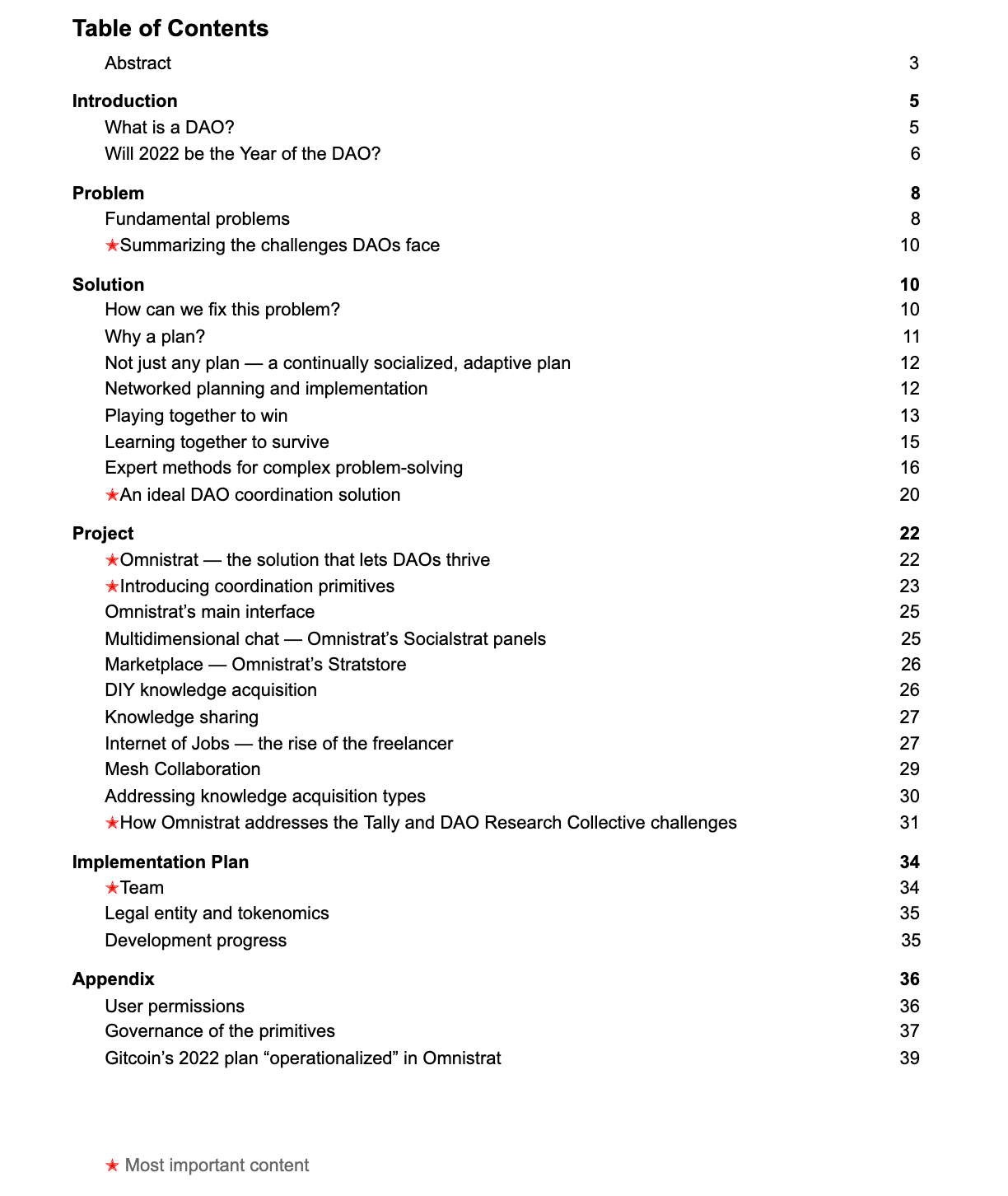
Introduction
What is a DAO?
Internet Policy Review, an open-access and peer-reviewed journal on internet regulation, defines DAOs this way:
A DAO is a blockchain-based system that enables people to coordinate and self-govern themselves, mediated by a set of self-executing rules deployed on a public blockchain, and whose governance is decentralized (i.e. independent from central control).
In this white paper, we will refer to DAOs as the people who are governed by the self-executing rules of the organization. We will refer to DAO tooling as the systems that enable these people to 1) coordinate the work they do to fulfill the DAO’s purpose and 2) deploy their self-executing rules on a public blockchain.
To better understand the history of the term DAO and how it’s been interpreted since it first emerged, read Internet Policy Review’s research paper here.
Will 2022 be the Year of the DAO?
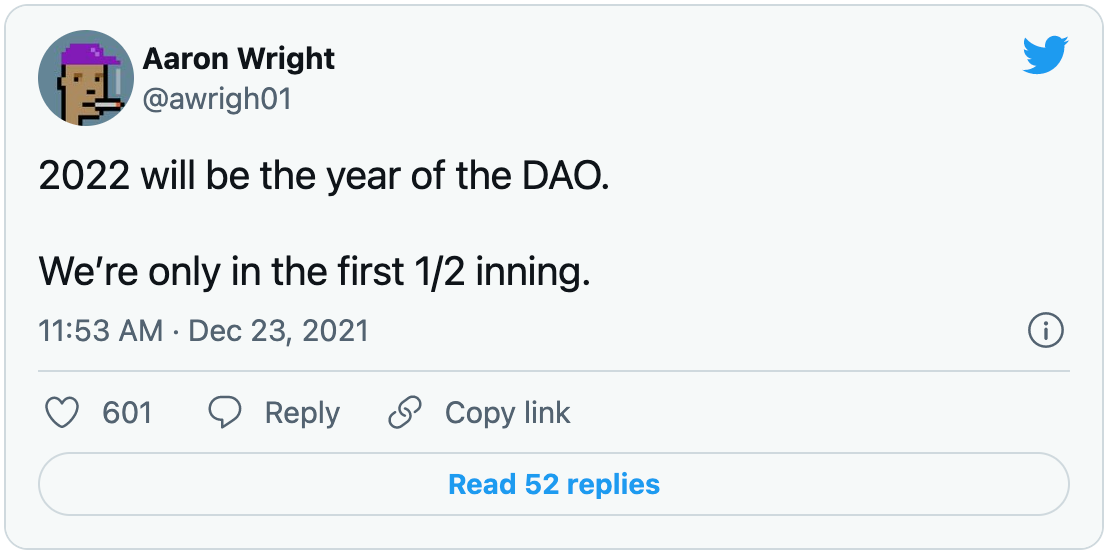
“The attention on social tokens and DAOs is starting to ramp up.” — Jess Sloss
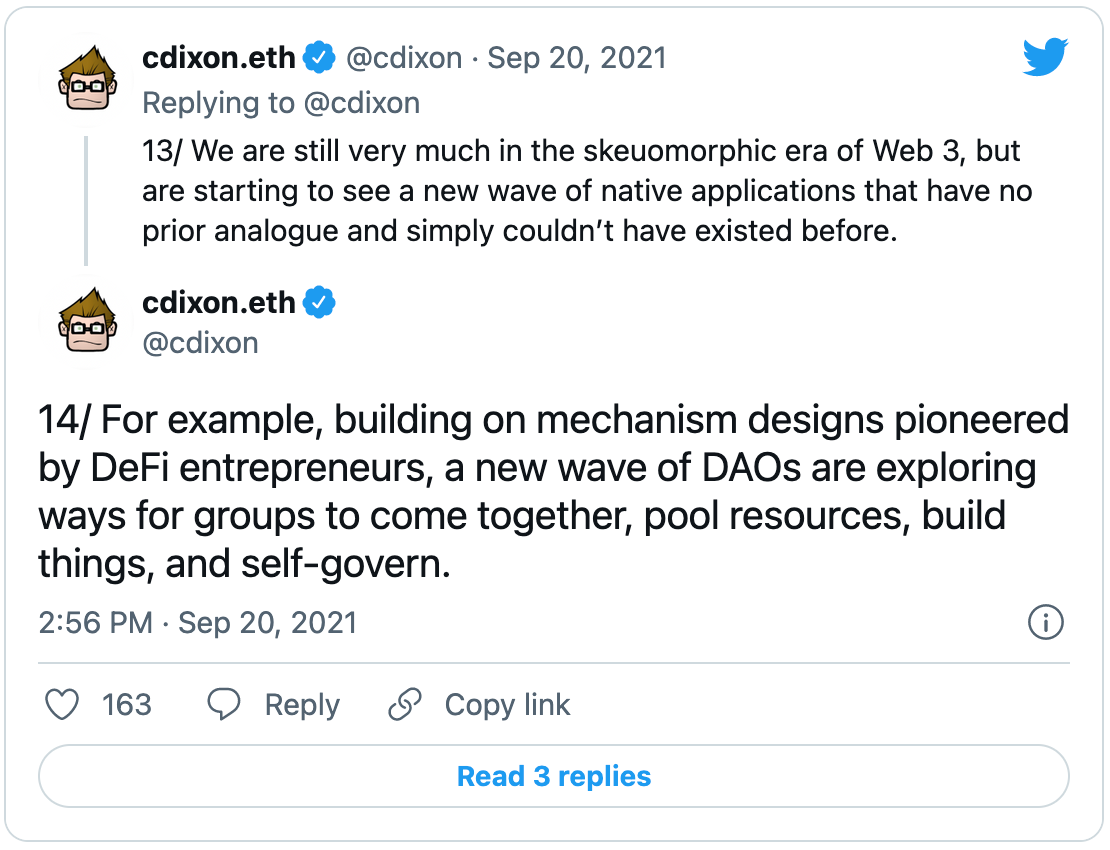
“DAOs are going to be more important over time.” — Vitalik Buterin
We seem to have reached a tipping point in enthusiasm for DAOs. Quite a few articles posted in the last month claim 2022 will be the Year of the DAO. Opportunity is driving this enthusiasm, but trepidation might be, too. Are we afraid it might slip through our hands?
In a foreword to a BanklessDAO post from Bankless writer Samantha Marin, Ryan Sean Adams, co-founder of BanklessDAO, said, “DAOs are the Opportunity of a Lifetime…We cannot squander this opportunity.”
In that piece, Marin went on to write, “This is the best chance humanity has ever had to win at coordination once and for all.”
Here’s a longer excerpt from Marin’s passionate piece on why DAOs matter and what’s at stake:
The Decentralized Autonomous Organization is the greatest governance and coordination experiment to gain real community traction in centuries.
We have — and are currently building — trustless, permissionless structures that allow anyone in the world to join an organization they believe in, put forth their talents, and earn money to do it. When I say anyone, I mean that in the strongest sense of the word: DAOs are agnostic to age, gender, race, ethnic background, economic status, nationality, residence, and any other demographic identifier that might prevent someone from working and earning money for something they believe in.
In the Web3 environment where anonymity is welcomed and encouraged, nothing about your background can be used to prevent you from jumping in, getting to work, and earning money.
This is a big f---ing deal.
We absolutely cannot take this lightly. We have a real opportunity here: to find the human coordination solutions we (the all-of-mankind “we”) have been seeking ever since humans first started walking upright. These solutions aren’t just elegantly built atop code — they’re our first real shot at a universally equitable work environment.
An equitable work environment is where anyone can work for what they want to achieve because everyone has the same tools to do so.
Marin’s explanation helps us understand that DAOs aren’t just a decentralized version of a profit-making company that operates without hierarchy. Just as critical is understanding that if done right, DAO tooling and the DAOs they form can beget an even greater achievement for humanity beyond a universally equitable work environment. When “anyone can work for what they want to achieve,” DAOs can also be the vehicle to solve the complex problems our world faces. We’re right to worry when the stakes are so high.
Problem
Fundamental problems
DAOs have fundamental problems that need to be solved before they can scale. Connor Spelliscy, the founder of the DAO Research Collective and co-founder of the Blockchain Association, wrote a post last year outlining the five major challenges, posed as pressing questions, that DAOs need to overcome in order to scale. Since the first three challenges fall under the same category, we can condense them to a final list of three:
- Legal — How can DAOs establish themselves as legal entities, establish compliant relationships with their workers, and limit liability for stakeholders?
- Governance — How can DAOs manage proposals, elections, delegation, and voting thresholds that are both scalable and equitable but still decentralized?
- Coordination — What are the best practices for hiring, onboarding, and managing talent at a DAO?
The legal issues are significant and will require collective action and advocacy. They won’t be resolved through software design or DAO tooling. Instead, it will take mobilization to impact the pillars of power. While Omnistrat can’t directly resolve legal issues, it certainly can support the mobilization that will need to take place.
With respect to governance, quite a few established projects (Gnosis Safe, Snapshot, Tally, Colony,) and many other tools can handle these issues in a myriad of evolving ways. Omnistrat’s dApp plans to serve as a protocol-agnostic DAO tool that sits atop the governance layer provided by these DAO framework tools.
While all of these challenges are important, coordination is of particular concern to us. We believe this is critical as the biggest hindrance to DAO adoption, and right now no project is addressing it appropriately.
In fact, Spelliscy’s article makes its own compelling argument for what the problem is:
Given the novelty of DAOs, it is difficult to find and vet talent that is well-suited to work in the generally nebulous and self-directed roles available in DAOs...
Once hired, DAO teams find it time consuming to transfer institutional knowledge to new workers, so DAO core teams often end up responsible for the majority of operations. Given the transparency of DAOs this seems counterintuitive but given the pace DAOs have evolved, these organizations have had a difficult time documenting their internal operations, making it hard to onboard new workers.
In addition to the problem of onboarding new contributors, there is the issue of helping new DAOs to form. Right now, the posts on DAO management contain more questions than answers and no easy way to share learnings or best practices between DAOs. Spelliscy mentions this in his article:
With DAOs starting to research legal, governance, diversity, treasury management, tax, and other issues, much of the foundational learnings and research of DAO stakeholders remain siloed within their own communities.
Tally just released a research report titled “DAO Contributor Challenges” in which they confirm DAO contributors’ experiences through surveys and interviews. Here are their discoveries:
- DAOs aren’t doing a good job of onboarding new members or giving them clear direction.
- New members don’t know what to do or with whom to connect when joining a DAO Discord; they don’t feel empowered to get involved, and they become overwhelmed or underwhelmed with their experience.
- DAOs lack consistent structure and tooling, making cross-DAO participation difficult.
- Incentives aren’t always clear or consistent enough to keep contributors engaged.
- DAOs struggle with finding consistent, accountable contributors.
- DAOs need open source tools that can fit all DAO needs through integration.
- On-chain governance is hard to understand for people who don’t have experience in DAOs.
Tally’s research provides some additional details about the problems with contributor incentives. These issues are also vital to understand because in cryptoeconomics code and economic incentives are intrinsically interlinked. Here are the report’s findings on incentives in DAOs:
- Financial incentives bring contributors, but opaque incentive structures demotivate contributors from continued participation.
- Financial structures in organizations aren’t always clear: bounties, working groups, core contributor status, new initiative leads.
- Processes for being compensated or becoming a full-time contributor are unclear.
You don’t need to understand cryptoeconomics to realize people need to be incentivized to contribute to a DAO. This is especially true if DAOs are to become the equitable work environments we envision. This means DAOs need to have a clear way to raise funds or generate revenue to pay their members when a purely altruistic member base is not possible.
Summarizing the challenges DAOs face
Below, we distill the challenges into the general buckets they fit into. Funding, as mentioned earlier, is a necessary component of the incentivization structure but is also a challenge.

Solution
How can we fix this problem?
What is causing the problem in hiring, onboarding, communicating with, and managing talent? Or, conversely, why are prospective contributors struggling with these same things on the other side of the equation? When you work backward, the frustrations articulated in these surveys and interviews point to a coordination problem and also give us clarity about what the solution is.
Coordination is defined as the organization of the different elements of a complex body or activity that enables them to work together effectively. What unique and central element provides the unifying coordination for a loosely connected network of individuals? The logical solution, as simple as it might seem, is a plan.
By a plan, we mean documented objectives and initiatives that will be implemented to achieve them. A plan simply answers the questions, “Where are we going?” and “How will we get there?”
Note: In this white paper, we will use the terms plan, big-picture plan, strategic plan, and strategy interchangeably.
Why a plan?
While the system managing the planning and implementation processes that encompass a plan needs to address a complex set of protocols, mechanics, and interactions, people understand the fundamentals of why plans work. The academic research into the benefits of planning and of a plan itself is voluminous (see implementation intention, future retrospection, and proactive coping).
Since DAOs don’t have a hierarchy, planning must be an open process. Open means the plan is transparent to the organization and to a broad set of participants who collectively develop the plan. This is known as open strategy, first proposed by Henry W. Chesbrough, University of California, Berkeley, and Melissa M. Appleyard, Portland State University, in their paper Open Innovation and Strategy (2007):
While it is difficult to precisely define the scope of these new developments, we believe that the concept of open source development and similarly inspired ideas such as open innovation, the intellectual commons, peer production, and earlier notions of collective invention represent phenomena that require a rethinking of strategy.
Research on open approaches to strategy has found compelling benefits. “Participation can generate engagement and create commitment to strategy and similarly improve the quality of decision making (Floyd & Wooldridge, 2000). In contrast, limiting participation through secrecy and exclusion may result in ineffective implementation (Mintzberg, 1994), and from a critical perspective, exacerbate organizational inequality (Knights & Morgan, 1991; McCabe, 2010)” (Cambridge Handbook of Open Strategy, 2019).
The cons are interesting as well: “However, participation can also slow down decision making and constrain the strategy process (Collier et al., 2004; Anderson, 2004). Moreover, widespread participation can create expectations that are then not satisfied, particularly where the decision might be contrary to the advice given by participants (Kornberger & Clegg, 2011).”
Of the two negative issues documented, the second is caused when an assumed “benevolent dictator” makes a call that overrules the community’s advice. This problem is one that DAOs, with their voting-based governance, shouldn’t have. Slowing down decision-making is the main trade-off of a decentralized organization.
Also, diversity of perspective matters. Science has shown us that progress and innovation depend less on lone thinkers with exceptional IQs than they do on diverse groups of people working together and capitalizing on their individuality, as social scientist Scott E. Page demonstrated in his book “The Difference: How the Power of Diversity Creates Better Groups, Firms, Schools, and Societies” (2008). Not only are plans necessary for improving coordination but open planning creates better outcomes.
At a basic level, a plan is extremely useful for bringing a community together and showing everyone the “big picture” plan. It’s no coincidence the term picture is used. In a phenomenon called the picture superiority effect, we respond to, process, and remember visual data better than any other type of data.
When you lack hierarchy, as DAOs do by definition, it is imperative to have a strategic plan. How else can contributors, coming and going as they do in a DAO, understand the organization’s goals, its progress, and their opportunities to contribute? A plan becomes the best communication device, onboarding guide, and talent coordination system a DAO can have.
Not just any plan — a continually socialized, adaptive plan
Don’t confuse this description of planning with the antiquated notions you might have from prior experiences with plans or planning. A plan today needs to be a lived environment that we can interact with, where the debate is happening in the context of the plan. It needs to ensure everyone has a voice. The core technology of strategy and innovation is the conversation.
Juanita Brown and David Isaacs, senior affiliates at the MIT Center for Organizational Learning, wrote a compelling and well-researched article on this topic, “Conversation as a Core Business Process.” They point out that we learn primarily through ongoing collaborative conversations. Learning is a social rather than an individual process.
Alan Webber, in his pioneering Harvard Business Review article “What’s So New About the New Economy,” goes one step further and asserts that conversation is the lifeblood of the knowledge economy. Where information is the raw material and ideas are the currency of exchange, he explains, good conversations become the crucible in which knowledge workers can share and refine their thinking in order to create value-added products and services. In his assessment, “The most important work in the knowledge economy is conversation.”
The authors go on to say it is essential to develop appropriate tools and environments to support good conversations if an organization is to reach its “strategic capacity to create the future it wants, rather than being forced to live with the future it gets.”
Networked planning and implementation
Today, success is not driven by the resources you control, but by those you can access. Rather than owning resources and capabilities outright, we need to tap networks of technology, talent, and information. The path to success, and even to survival now, is effectively conversing and coordinating with these networked resources.
To achieve this goal, we need to solve complex problems with breakthrough innovations that emerge from multi-party collaborations. The right DAO coordination tooling can facilitate the specialized environments required to do this effectively.
This opportunity couldn't be coming at a more urgent time. The world’s problems are getting more complex, and the consequences are accelerating.

Playing together to win
The evidence is clear. In a world pervaded by digital technology, power no longer resides at the top of hierarchies, but at the center of networks. Movements become successful by expanding out, always seeking to widen their appeal. Those that continue to play to a narrow constituency of stakeholders eventually find themselves stuck on the periphery. This principle holds true whether you are seeking change in an organization, an industry, or throughout society as a whole.
Greg Satell in “Cascades: How to Create a Movement That Drives Transformational Change.”
The idea this excerpt represents is something the Web3 community needs to understand and embrace if we want to achieve the potential of DAOs and cryptoeconomics as a whole. I encourage everyone to read Satell’s book. It’s fascinating and often counterintuitive — exactly the right game plan for a community that needs to think like a movement.
This is important for our decentralized worldview so that we can evolve the thinking that, to participate in it, you have to make a hard break between the old centralized world and the new decentralized one. The reality is we’ll have to build bridges between the two worlds to realize our decentralized vision. This isn’t just a matter of appealing to the DAO-curious by being inviting and friendly. We’re doing a great job of that already. We need to eventually reach everyone, including the detractors.
This inclusiveness is based on Granovetter's threshold model of collective action and George Lakey’s spectrum of allies tool. Movements win not by overpowering their active opposition, but by shifting the support out from under it. As Greg writes:
Yet it is not connection alone that creates a cascade, it is connection to higher threshold groups. That’s a challenge, because it means that you cannot only seek out the like-minded, you must also bring in the unconvinced, the skeptical, and the oblivious. If the desire for change remains with the zealots, it won’t go anywhere. It’s only when everybody else joins in that a transformational change can take place.
Accepting that this new world of DAOs does not exist in isolation, we need to create the network paths (the bridges) that will connect the nodes of this network (the people) no matter where they stand today. We also need to plan ahead, looking for ways to win over the next higher threshold group in our spectrum of allies.
The bridges between the nodes are plans, specifically transparent and open plans. The DAO-curious are already here, knocking on the door, and the most determined are getting involved. We need to start using open, transparent plans to more easily onboard the less determined. At the same time, we need to prepare for the next group in our spectrum of allies. A good next bet are skilled service professionals operating as freelancers.
DAOs need to onboard more non-technical community members. Freelancers are already comfortable working as free agents in a project-based system, often supporting multiple clients. They also possess skills that DAOs need: marketing, design, legal, research, talent management, accounting, finance, branding, growth, and more. We cover this concept further in the Project/Internet of Jobs section.
Learning together to survive
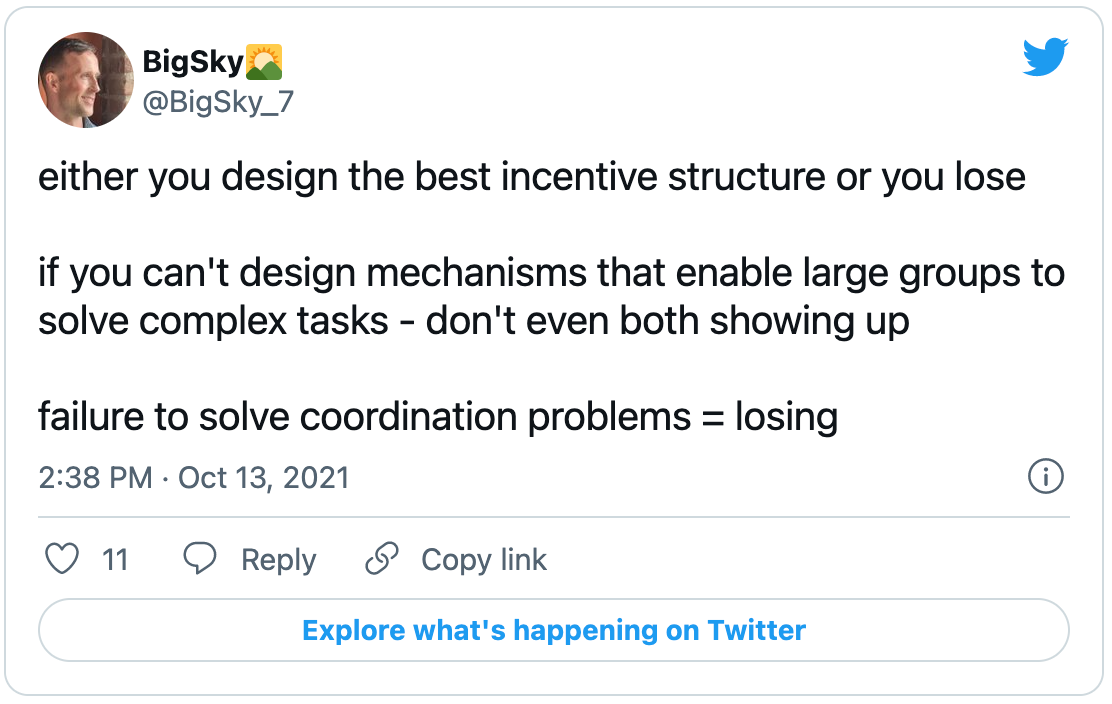
With the world’s problems growing more complex and the consequences accelerating, we need to think beyond winning and losing, to survival. To do that, we need to empower learning at scale. John Hagel III, founder and former leader of Deloitte’s Center for the Edge, describes this as a learning platform in his recent book, “The Journey Beyond Fear: Leverage the Three Pillars of Positivity to Build Your Success”.
Platforms will become more and more central to our survival, much less our success, because they have a unique capability to accelerate learning.
Platforms will get really interesting when they are specifically designed to mobilize participants to learn faster as they work toward a common goal, doing things that have never been done before.
A learning platform is not a learning management system (LMS). An LMS makes individual learning easier by aggregating tutorials or courses. The critical distinction is that people learn faster by acting together, as we described earlier. DAO coordination infrastructure that’s designed as a learning platform is a powerful combination. Again, as John Hagel said:
The platform must also leave space in which participants can come up with new approaches themselves. Some of the most powerful learning occurs when we see something that no one else had thought of. Such an insight can lead to a totally different set of approaches, perhaps with far more impact.
It’s helpful to understand the different scenarios we find ourselves in when it comes to what we know and how we acquire knowledge when we don’t know. This two-by-two matrix below breaks down four scenarios to show how we acquire knowledge and what to understand about it.
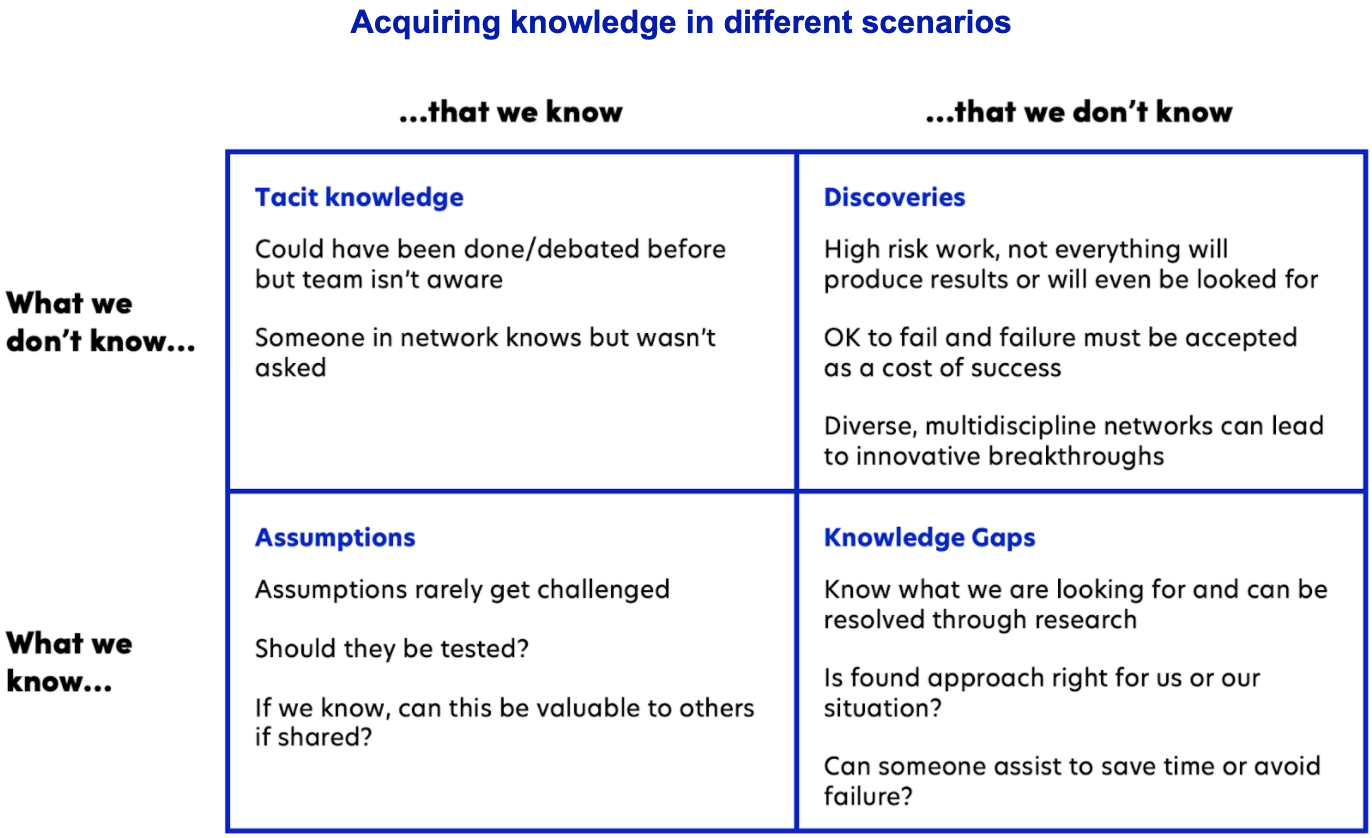
A learning platform, if it is to be truly useful, needs to guide its users in a structured process to find the answers they seek. These processes should be methods proven to work for the different situations that groups will encounter. There aren’t many, but these expert methods exist. Fewer still are methods that work in loosely connected networks to solve complex problems. One in particular seems perfectly suited to DAOs.
Expert methods for complex problem-solving
Solving complex problems in loosely connected networks, where nobody can tell anybody else what to do, presents unique coordination challenges. One successful approach that took 20 years of fieldwork and complex testbeds to refine is Strategic Doing. Ed Morrison, director of the Agile Strategy Lab at the University of North Alabama, pioneered this expert method, which is now a global open-source project with thousands of practitioners. It has real applicability to DAOs.
Morrison had this to say in the abstract to his doctoral thesis, “Strategic Doing: A Strategy Model for Open Networks” (2021):
First, can an open, loosely connected network, operating outside the boundaries of any single organization and with no pre-existing routines of governance, form and execute a strategy? If so, how?
Second, can these open networks strategically develop solutions to complex, wicked problems? Again, if so, how?
The questions were rhetorical. Strategic Doing is the answer to both of these questions and a great example of an expert method. Let’s first look at the types of problems this method is designed to solve.

This matrix shows the different levels of complexity on the two dimensions involved in solving problems, the problem itself and the type of collaboration present. Expert methods are helpful when the dynamic reaches the situation shown in the upper right four cells. This is the territory of wicked problems.
We find wicked problems everywhere: persistent poverty, nationalism, and white supremacy; economic dislocations from globalization; pandemics; food insecurity; biodiversity loss; and climate change. The United Nations’ 17 Sustainable Development Goals are a collection of wicked problems. These are pressing needs that can’t be ignored.
Here is what Morrison had to say in a LinkedIn post that captures a bit of the unique challenge and the philosophy of Strategic Doing:
Yesterday, a colleague asked why we don't use the term "goals" with Strategic Doing. Instead, we focus on outcomes that we can measure. What's the difference? . . .
When we encounter an adaptive challenge — a wicked problem with no set solution — we don't really know what a solution looks like. All we have are hypotheses. In this situation, we should set outcomes, not goals.
Outcomes are multi-dimensional and somewhat uncertain. Yet, they provide the coherence and direction we need to move into action, to experiment. They point us to the design of new systems — new arrangements, connections, and routines — that improve our lives and provide better results.
Goals, on the other hand, are tightly drawn and specific. They work well with established routines, in situations with clear, tried solutions. They reflect a singular perspective. As we pursue them, we narrow our focus and reduce our field of view. Applying goals to an adaptive challenge carries a significant cost. We reduce our flexibility and restrict our opportunities to learn something new.
The concept is simple: there are four questions and 10 rules, which can be codified in software. It starts with the same premise that defines a strategy: Where are we going, and how will we get there? Though, to provide the needed structure when the solution is unknown, Strategic Doing breaks the two questions into four.

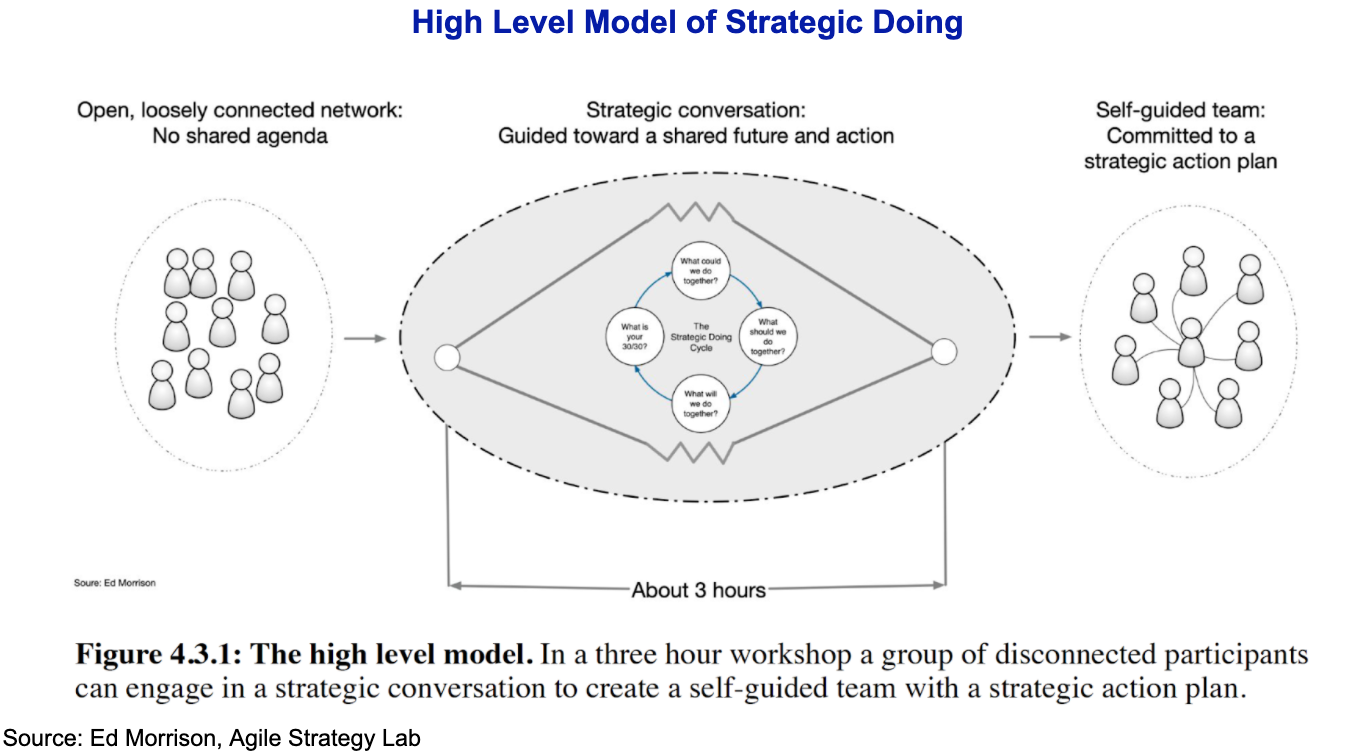
The diagram below is from Morrison’s dissertation and shows the community diffusion that happens in Strategic Doing. This diffusion is why these kinds of methods are so powerful. The example illustrates how the discipline can diffuse rapidly through networks.
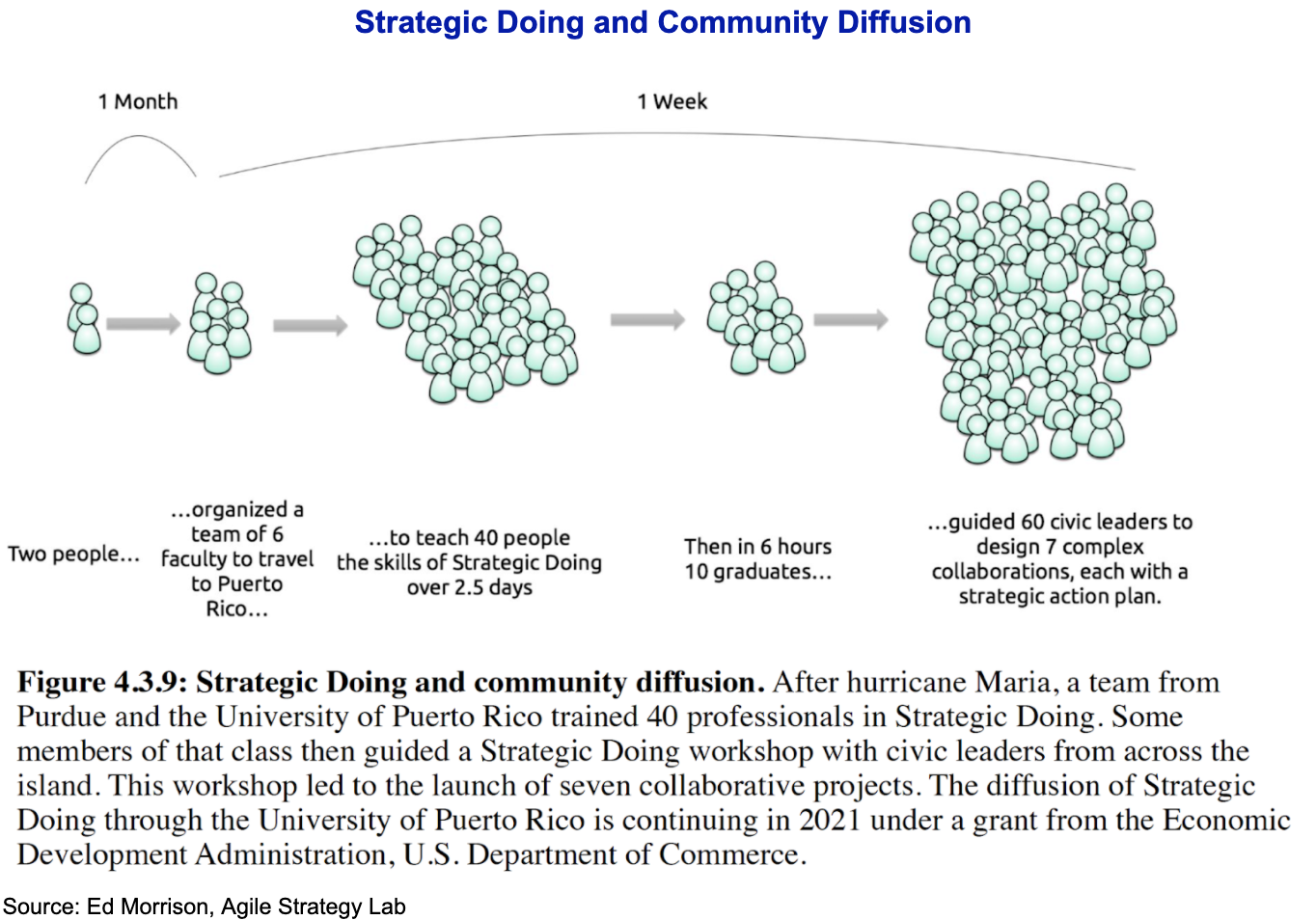
As you can see, learning platforms that use an expert method to guide participants through a structured process on their journey to solving complex problems have huge potential.
An ideal DAO coordination solution
Below are two lists. The first summarizes the above research findings on the attributes of a best-in-class coordination system for open loosely connected networks. The second is a set of recommendations the Tally and DAO Research Collective posts offered to solve unique DAO coordination problems. Together these two lists provide a good cross-section and comparison of what coordination should look like for DAOs.
Research recommendations for solving the coordination challenges of DAOs
- Visual Plans — Plans are the foundation for coordination in open, loosely connected networks. They answer the questions, “Where are we going?” and “How will we get there?” and can do so visually and easily.
- Open and Transparent — The most effective plans are created by a diverse group of participants. The resulting plan should be accessible to everyone involved in putting it into action.
- Social and Adaptive — The environment needs to support strategic conversations in context with the plan and support an adaptive, experimental approach as the plan is carried out.
- Open Network — The architecture of the network should be open, becoming a bridge between the old and the new. This will better facilitate an eventual cascade in a “movement” dynamic, if one is to happen.
- Learning Platform — The system should be specifically designed to mobilize participants, help them learn faster as they work toward a common goal, and empower them to easily share their learnings at scale.
- Expert Methods — Platform developers should embed structured processes that guide complex problem-solving through expert methods.
Tally and DAO Research Collective’s recommendations for solving DAO coordination challenges
- Improve searchability so people can find and join DAOs that are aligned with their goals
- Provide a trustless, easy way for DAOs to vet new members’ skills
- Promote ease of use for non-technical and non-Web3 members
- Allow contributors to take self-directed ownership of what needs to be done
- Allow cross-DAO coordination through structured processes
- Promote accountability, consistency, and transparency
- Provide feedback loops to better understand what went well and what could be improved
- Facilitate inter-DAO (D2D) collaborations
- Enable integrations with the inevitable tool stack for a complete and seamless solution
- Ensure the ability to scale learning through structured approaches and the sharing of best practices
Together, these lists provide a model to compare the solution Omnistrat has developed and has on its roadmap.
Project
“You can’t just have a DAO to be a DAO. You need a DAO to do something.” — Vitalik Buterin
Omnistrat — the solution that lets DAOs thrive
Our vision is to make the world a better place through DAOs. We accomplish this through a decentralized web application (dApp) and marketplace based on new coordination primitives (plans and their building blocks). Our mission is to be the bridge that onboards the next billion users by serving the Layer 0 protocol — the human layer.

Components of the platform
DAO Coordination Infrastructure
- Coordination primitives — standardized, composable plan building blocks
- Coordination dApp — transparent and open planning and implementation
DAO Learning Platform
- Marketplace of know-how — expert and community-derived best-practice playbooks
- Internet of Jobs — a marketplace of talent and expertise
- Integrated expert methods — guide complex problem-solving
DAO Scaling System
- Integration — interoperability with necessary DAO governance tooling
- Abstraction layer — shield non-Web3 users from the arcane aspects of blockchain
- D2D networks — DAOs that can easily work with each other through “mesh collaboration”
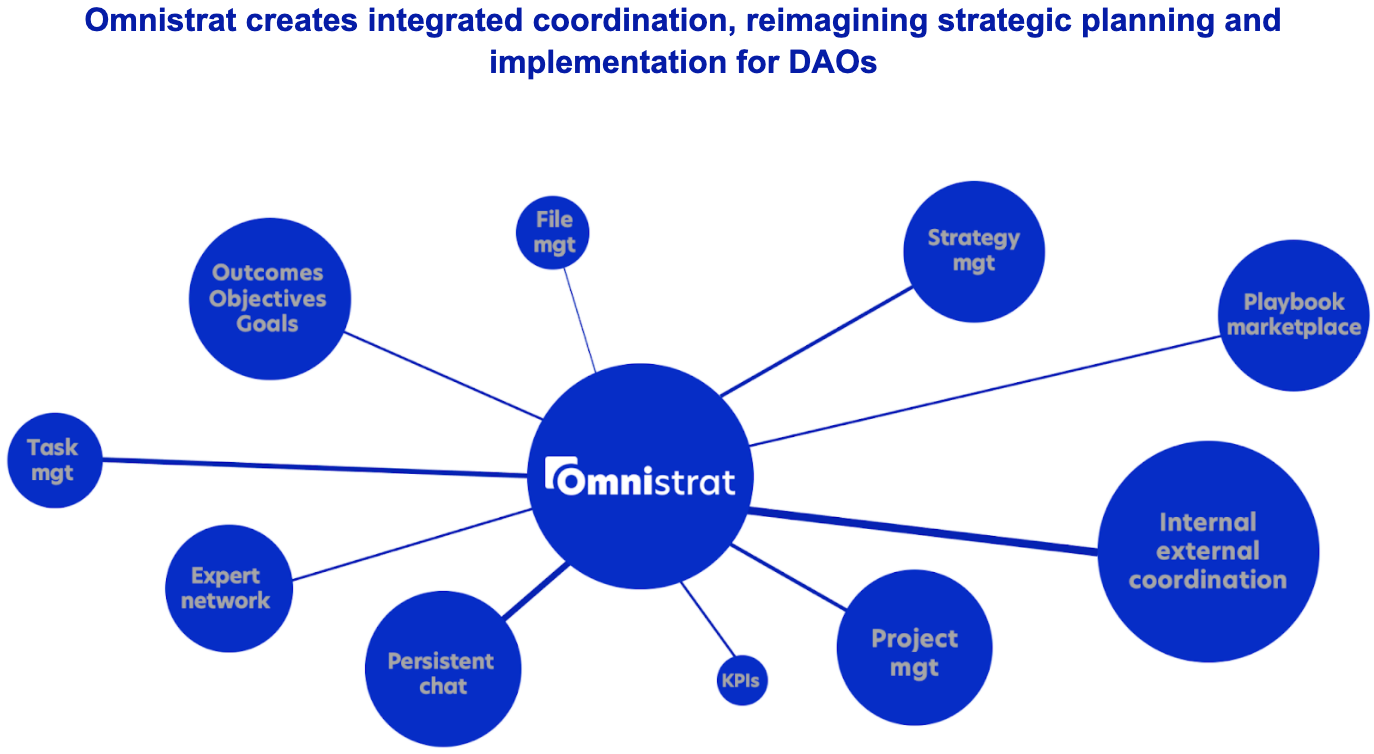
Introducing coordination primitives
Primitives are the building blocks of a token-based society, a society in which DAOs provide a new model for community action. Coordination within a DAO and collaboration between DAOs are principal functions to facilitate that action. Standardization for interoperability, composability, and sharing is crucial to enable coordination within and collaboration between DAOs. Therefore, coordination must have its primitives. Omnistrat seeks to establish the coordination primitives for DAOs as follows:

The five interdependent primitives above represent the building blocks used to create plans.
S = Strategic Plan — the parent object for a plan. It’s a container for the other building blocks. It captures the time frame in which the plan should be completed and the narrative for the plan.
O = Objective — captures the goals or outcomes your organization wants to achieve.
I = Initiative — the projects your organization implements to achieve an objective.
A = Action Item — the steps needed to carry out an initiative.
G = Group — used to organize your plan by grouping Objectives, Initiatives, or Action Items.
These primitives are “coordination legos” that allow DAOs to create objectives, workstreams, initiatives, and plans. Their governance properties align with existing blockchain standards.
- Coordination primitives can be used to capture and productize knowledge and expertise.
- Coordination primitives can be used to plan work, pathways forward, or bounties.
- Coordination primitives have composability, creating interoperability between DAOs and blockchain protocols.
- Coordination primitives have transitory states that show what has been proposed, what has been approved for action, what has been rejected, and the outcome of any object once completed.
Omnistrat’s main interface
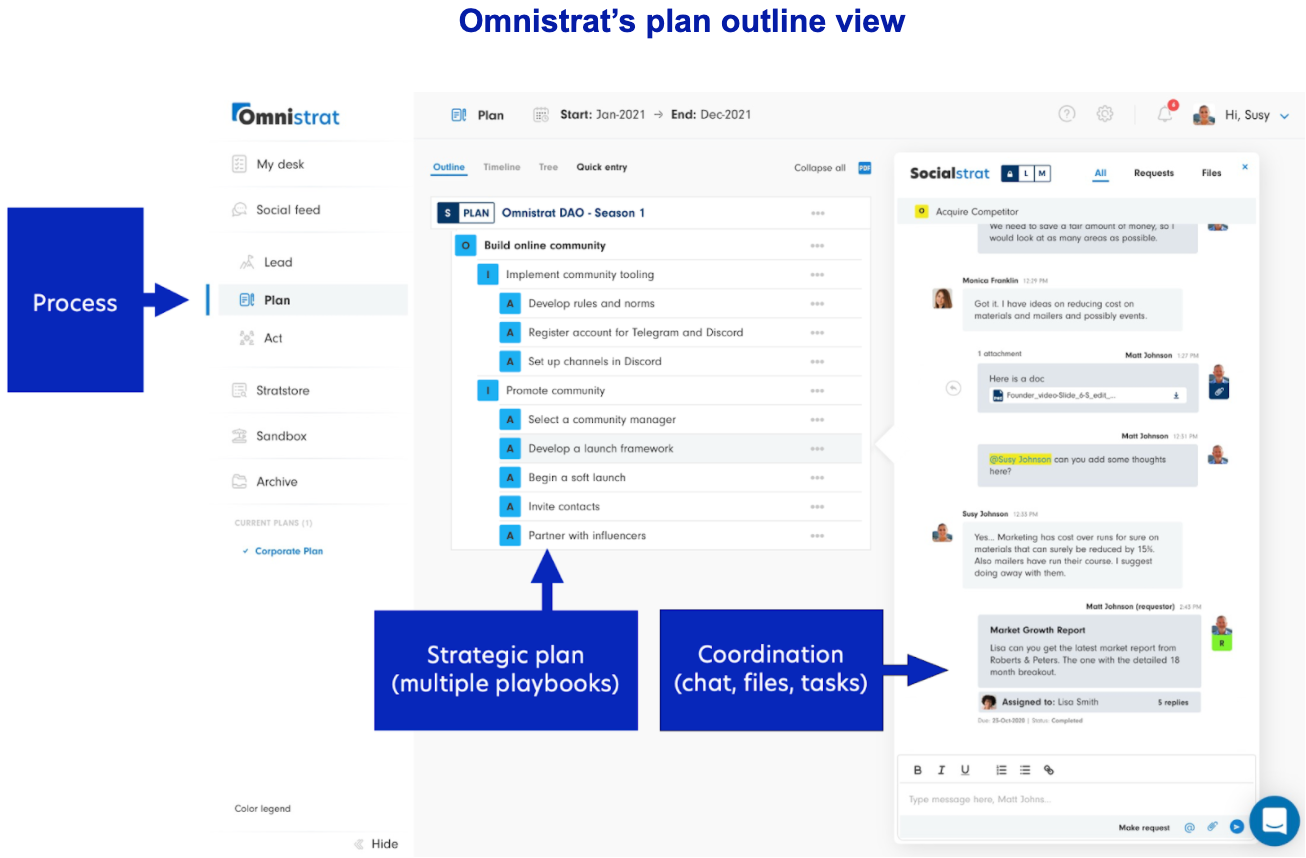
The main views to present your plan are Lead, Plan, and Act. The reason for having these views is to both support a generic planning and implementation process and to support the tiered user access environment involved with that process. The views allow for the different types of conversations that happen in planning and implementation. When you are creating or implementing a plan there is one plan, but three types of conversations. We call this multidimensional chat.
Multidimensional chat — Omnistrat’s Socialstrat panels
Our Socialstrat panels host these multidimensional chats. Also known as SSP’s. This is where you chat with other DAO members, attach and discuss documents and files, assign and manage requests, and initiate off-chain and on-chain voting.
The best way to understand how Omnistrat works is to watch this video demo.
See the appendix for additional information about the governance involved in Omnistrat’s planning and implementation process.
Marketplace — Omnistrat’s Stratstore
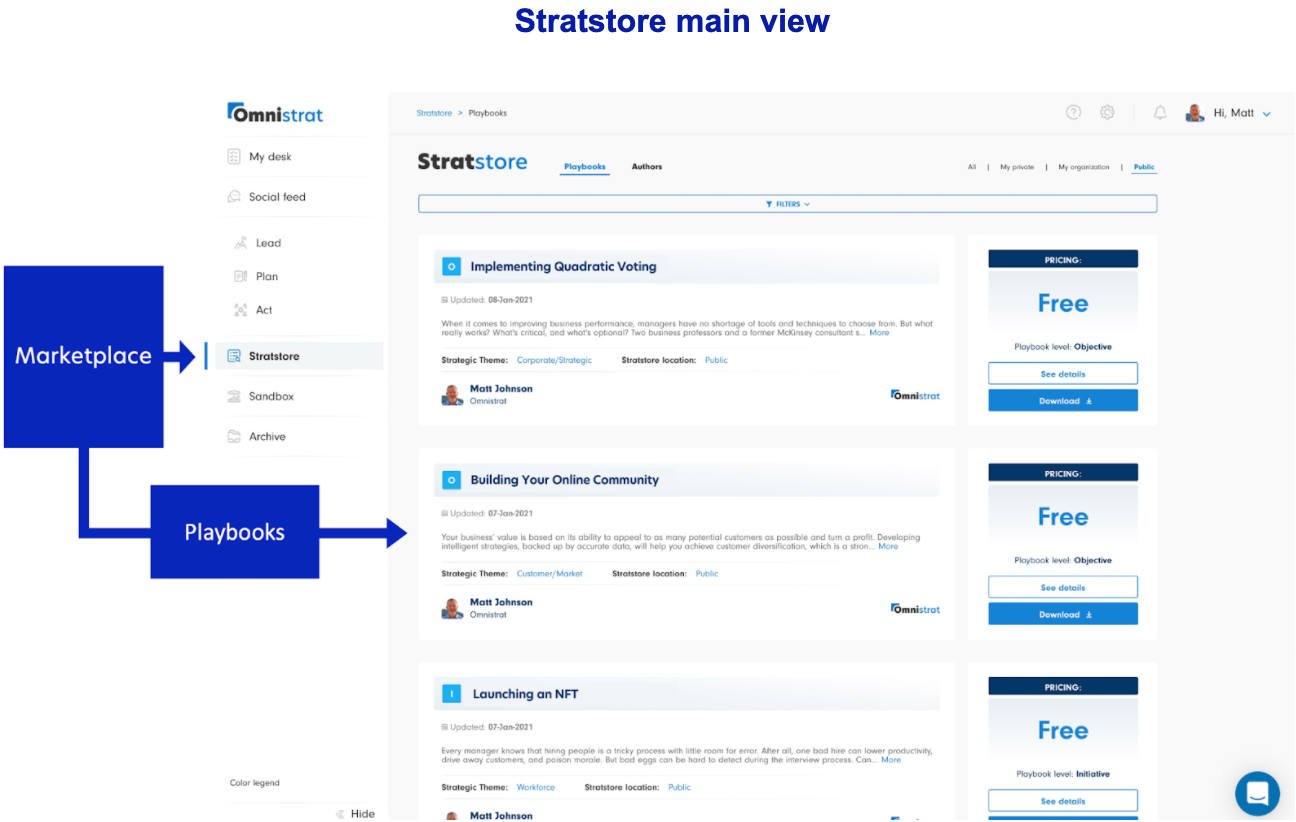
Omnistrat’s Stratstore solves three significant problems by making it possible to:
- Share knowledge at scale between DAOs
- Empower skilled services professionals to scale their freelancing practices
- Find and hire talent for a DAO’s specific needs
All three of these problems can be solved using coordination primitives. Uploading playbooks to the Stratstore allows people to share their knowledge. From a list of action items to a detailed strategy plan, playbooks can contain any combination of coordination primitives.
DIY knowledge acquisition
People who are confronted with a knowledge gap ("What we know that we don't know" from the preceding matrix) must usually invest time researching to figure it out. That's a lot of work. There are times when you're unsure if what you've found is appropriate for your DAO's circumstance, detail is missing, or you're unsure what success looks like.
The ability to browse for playbooks saves a lot of time and, by design, they set out all of the processes to follow. Because playbooks are modular, a DAO can combine numerous playbooks into one plan.
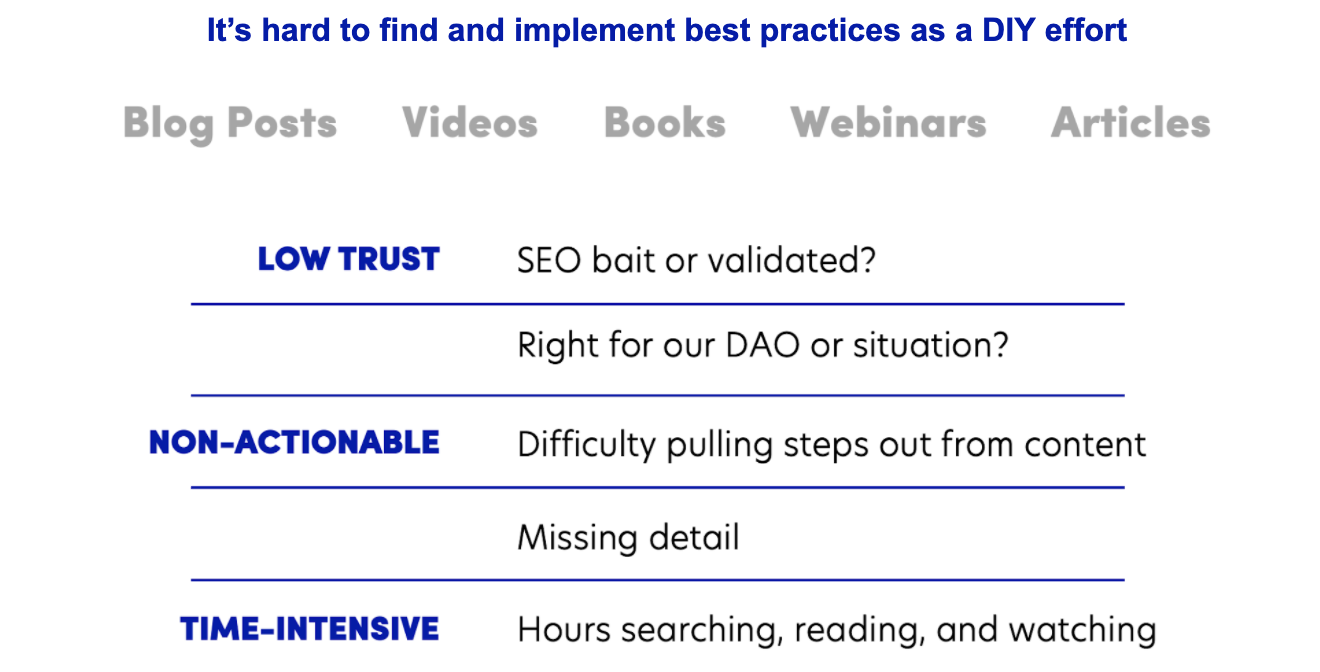
Knowledge sharing
Simply by implementing a collaboratively derived plan, you will automatically be documenting what the DAO is doing and what worked. When the implementation is done, DAOs can turn any aspect of their plan into a reusable, shareable playbook. A system that equips people to share knowledge at scale and with ease is the definition of a learning platform.
Internet of Jobs — the rise of the freelancer
The second problem is about giving freelancers a marketplace that works for them. Kevin Owocki, the founder of Gitcoin.co, described the Internet of Jobs (IoJ) in an article here. With Omnistrat, the provider of the services has a say or control over what they are paid. This works out great when a DAO needs specialized help and wants an expert involved in the implementation.
Freelancers have historically traded hours/labor for money. One problem with this dynamic is that it is really hard to scale their practice because time is finite. One way to overcome this problem is to turn the work a freelancer would do for a client into a playbook. A freelancer can receive value for the playbook in a number of ways (charge for it, have the community fund its development as a public good) or offer it for free.
A freelancer’s ability to productize their services is currently not available in talent marketplaces, including in the few blockchain-based ones operating now. All of these solutions force freelancers to trade labor for hours.
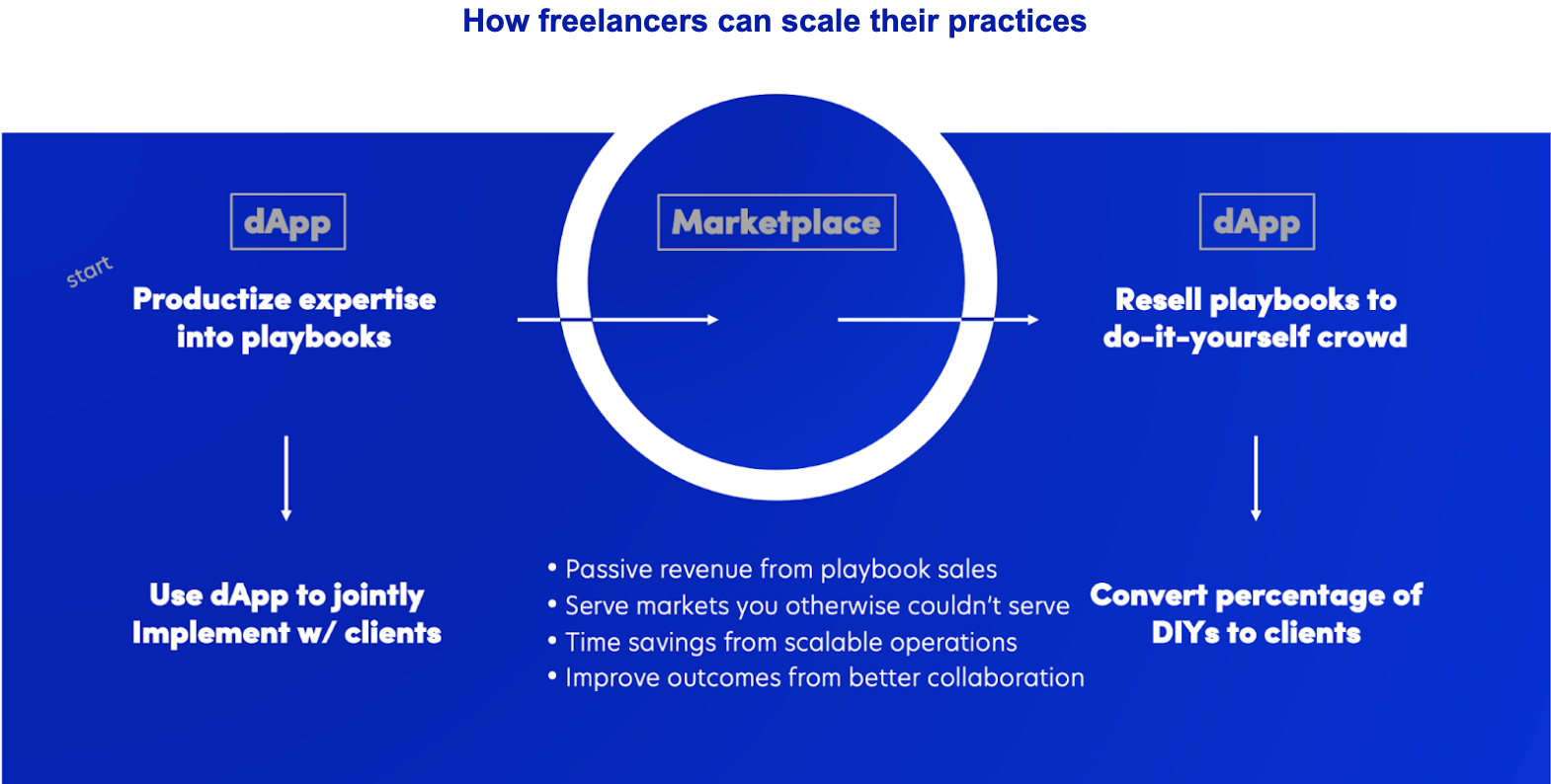
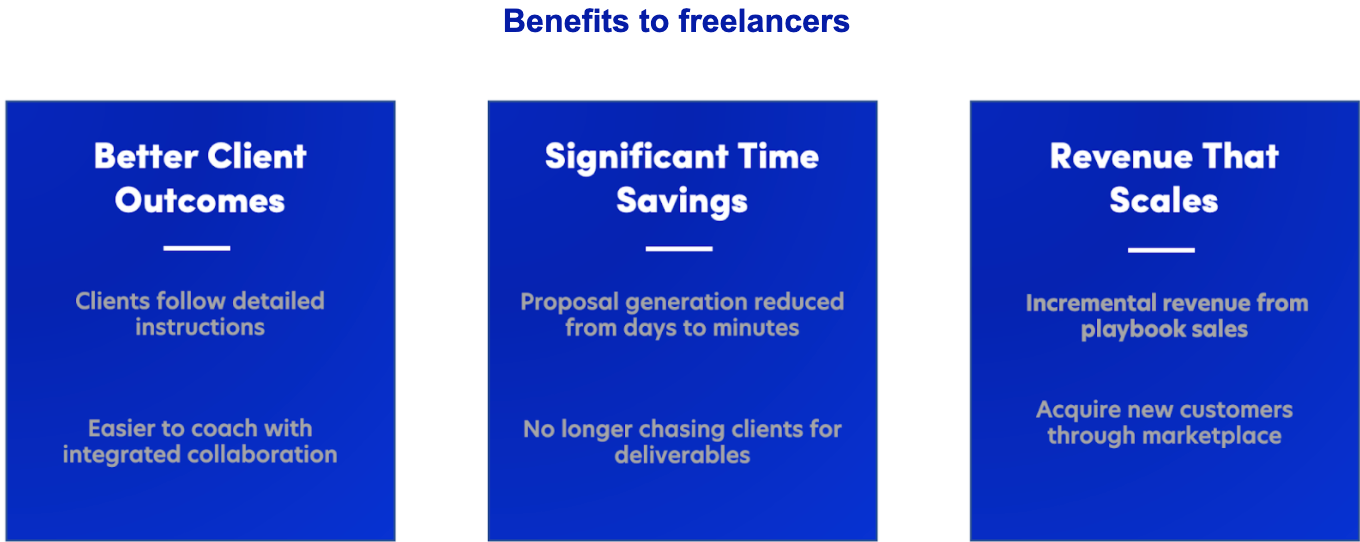
Mesh Collaboration
We support live collaborations between DAOs through what we call “mesh collaboration.” Standardized plan primitives makes this possible.

The concept came about from the evolution we were seeing in strategy formation. The first-generation strategy management style, top-down, is still the predominant approach in companies today. It’s also the antithesis of what DAOs stand for.
Traditional companies and DAOs need the second-generation approaches, agile and open, more than ever to run, and these methods are a core part of Omnistrat’s approach. Agile, as its name implies, is a strategy that is expected to change based on what is encountered. Open refers to expanding the number of participants, especially lower-level members, to include more diversity of thought and create better plans.
We have pushed this concept further, based on how DAOs operate, to introduce mesh collaboration. Unique to Omnistrat, mesh collaboration allows involved organizations (nodes) to share initiatives directly, dynamically, and non-hierarchically for seamless cooperation. The shared initiative is an embedded component of each node’s own strategic plan.
Also, DAOs can initiate new D2D collaborations through the DAO directory and social/mobilization layer. Announcing contests, crowdsourcing challenges, and the need for certain expertise is a great way to tap into a large network of potential DAO partners.
Addressing knowledge acquisition types
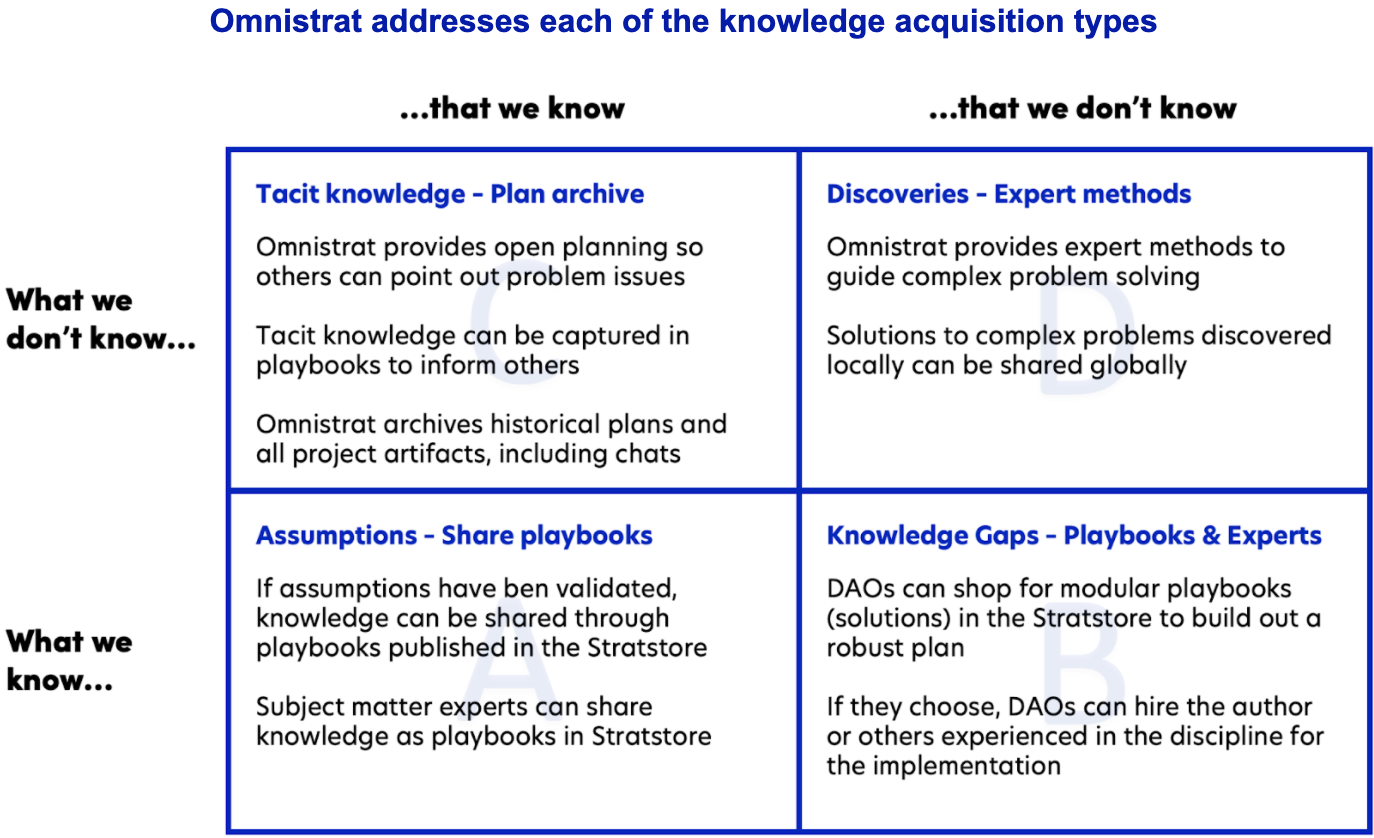
A. If an assumption about how to do something is validated and valuable, it can be turned into a playbook and published in the Stratstore. Skilled services professionals, i.e., subject matter experts, can capture their expertise in the form of playbooks as well.
B. Those who seek best practices or solutions to the challenges they face can shop for playbooks. Playbooks are modular so they can be merged with existing plans.
DAOs can also hire the authors of those playbooks or seek out others who have experience with implementing these playbooks.
C. The concept of tacitness in a group setting is challenging. Think of it this way: One part of the group is oblivious while another part has awareness. An oblivious group can reference Omnistrat’s archived plans to see if an issue has been addressed before or, through open planning, an aware group can point this out to the oblivious group.
D. If in the course of getting to where a DAO is going members make a discovery, they can save the successful “recipe” as a playbook for future internal use, share it as a public good, or charge for its use. Discoveries are more likely if they use an integrated expert method to guide them through the problem-solving process.
How Omnistrat addresses the Tally and DAO Research Collective challenges
Below we consider each recommendation and lay out how Omnistrat meets these requirements.
1. Improve searchability so people can find and join DAOs that are aligned with their goals
DAO DirectoryOmnistrat will create a searchable directory of DAOs with profiles pulled from Omnistrat data and other data sources. As a start we can base searchability on these categories:
- AMM/Protocol DAOs
- Grant DAOs
- Social DAOs
- Collector DAOs
- Venture/Investment DAOs
- Service DAOs
- Research DAOs
- Media DAOs
- Social Media DAOs
- Entertainment DAOs
- Problem-Solving/Advocacy DAOs
Social/mobilization layer for communities of interest
We will add a social/mobilization layer to Omnistrat for people who did not find what they were looking for in the DAO directory or already have their own agenda for action. An open social platform layer, divided by the same categories above, will facilitate the search process for people to find like-minded peers, mingle, and then form collaborations.
Note: Discord is a good platform to facilitate social interaction within a specific DAO, but not for a directory with a social/mobilization layer organized by DAO categories.
John Hagel III describes mobilization platforms well in his book, “The Journey Beyond Fear: Leverage the Three Pillars of Positivity to Build Your Success.”
A mobilization platform takes common interests to the level of action. Users don’t just have conversations about common interests on these platforms; they focus on moving people to act together to achieve a shared outcome beyond the capabilities of any individual participant.
The DAO directory and social/mobilization layer will also carry announcements from DAOs to affiliated peer communities. Announcements might be contests and crowdsourcing challenges and notifications about new learnings or successes that have been captured in playbooks. Its greatest value may be as a DAO’s new member recruiting destination.
2. Provide a trustless, easy way for DAOs to vet new members’ skillsVetting new members who will be conducting critical work for the DAO is always a challenge if the member has no history with the DAO. Coordination primitives can help. If encoded to a smart contract, a member’s experience implementing a playbook will trustlessly prove their experience and the outcome achieved.
DAOs can even use this insight to reach out and recruit members with the playbook experience they need. This is on top of the ability to hire the authors of the playbooks in the marketplace.
3. Ensure ease of use for non-technical and non-Web3 membersOmnistrat's concept is an all-in-one planning and implementation solution that is easy to use. Many of its features, such as persistent chat, project management, and goal-setting (OKR) are already recognizable to users.
4. Allow contributors to take self-directed ownership of effortsAction items, the base tasks for individual users, will clearly show if they have been assigned or not. DAO members will be able to scan the open action items and grab the ones they want to accomplish. The owner of the initiative will receive automatic notifications when someone has selected an action item. This takes the burden off the initiative owner of having to proactively assign and manage work. Instead, they can simply react when they choose to.
Members can also create action items to do themselves or to assign someone else to do. This allows the community to create the details of how an initiative should be implemented or course-corrected.
5. Allow cross-DAO coordination through structured processesOmnistrat was designed for an open strategy approach. This gives members of an organization a view of the entire plan, making cross-functional planning easy to promote and manage.
DAOs can engineer the structured process in two ways. They can use the Group building block to show different teams’ efforts in implementing a plan or they can create cross-functional teams, using the ad hoc teams feature to facilitate this.
6. Promote accountability, consistency, and transparencyLet's address these in reverse. Transparency means having a plan that everyone, inside and outside your DAO, can see. They know what the DAO is trying to accomplish, how well it’s going by virtue of turning the plan into the dashboard with outcome states, and what is left to do. Everyone’s conversation about planning and implementation is also open to being read if so chosen. Lastly, you can also track what the community chose not to do.
Plan building blocks as primitives make everything consistent. The building blocks also get everyone to think in terms of desired outcomes and steps to make those outcomes happen. There is also consistency when using playbooks. If you discover on your own how best to do something, then you can document and reuse or share it with other DAOs.
Accountability is built into the tool through five attributes being documented for every action item, initiative, and objective. The attributes are sponsorship, ownership, success criteria, outcomes (i.e., expectation met, expectation not met, or abandoned), and final comments, all embedded in the primitive.
7. Provide feedback loops to better understand what went well and what could be improvedFeedback loops are built into the tool when team members document outcomes for every action item, initiative, and objective. The outcomes are “Expectation met,” “Expectation not met,” or “Abandoned.” This turns the plan into a dashboard that communicates how well things are going, providing live feedback loops on implementation. Postmortems are also baked in with the use of final comments for objectives, initiatives, and action items.
One more element: The way outcomes are structured makes a distinction between completed work and whether that work created the desired outcome. This is helpful if you’re in experimentation mode. You want to reward people for completing the work even if you didn’t get the results you wanted.
8. Facilitate inter-DAO collaborationsDAOs can collaborate with each other using Omnistrat’s mesh collaboration technology.
9. Enable integrations with the inevitable tool stack for a complete and seamless solutionOmnistrat does not plan to develop voting or treasury governance tooling. We will integrate with DAO tooling to support this seamlessly within DAOs. Our most likely first integration partners will be Snapshot and Tally for off-chain and on-chain voting and possibly Colony for a DAO framework. Treasury will be handled by integrating with Gnosis Safe. With Solana, we would be looking at Squads, Goki, and Sollpay.
10. Ensure the ability to scale learning through structured approaches and sharing of best practicesOmnistrat’s greatest strength is its ability to deliver on both of these methods. It scales learning through a structured process by incorporating expert methods. Our first supported method will be Strategic Doing, an open source project overseen by the Agile Strategy Lab. We share best practices through playbooks in a marketplace, Omnistrat’s Stratstore.
When combined with the social/mobilization layer, DAOs can also incentivize scaled learning through contests and crowdsourcing solutions. Entities can post a problem or challenge and offer a reward, grant, or bounty to the participant or organization that comes up with the best solution in the form of a shareable playbook.
Implementation Plan
Example Plan
This plan was cobbled together from multiple sources. Each group represented in this plan was in a different format based on the preference of its author(s) and from different systems including Notion and Google Docs. Omnistrat, using coordination primitives, was able to pull this together into a standardized “big picture” plan.
Now new members and old can see what Gitcoin is trying to accomplish and how. This will give them context to add their own voices and ideas to the process. A more diverse set of participants will make for a better plan and will only improve as the community adapts to conditions encountered as they implement the plan.

Join Us - Making the world a better place through DAOs
If you would like to join us on our journey please reach out. Our community can be found on Discord. Eventually, we will have our strategic plan publically available so you can see what we’re up to and jump in where you think you can make a difference.
Omnistrat Discord
Omnistrat website